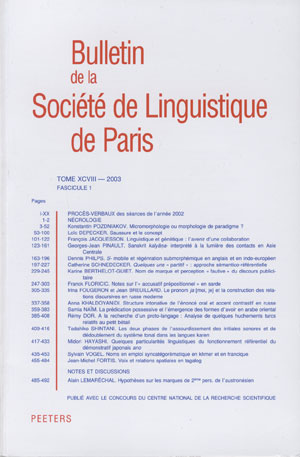 previous article in this issue previous article in this issue | next article in this issue  |

Preview first page |
Document Details : Title: Pourquoi la typologie des langues est-elle possible? Author(s): HASPELMATH, Martin Journal: Bulletin de la Société de Linguistique de Paris Volume: 104 Issue: 1 Date: 2009 Pages: 17-38 DOI: 10.2143/BSL.104.1.2046986 Abstract : Que la typologie des langues soit possible n’est pas une évidence compte tenu de la diversité des structures grammaticales. Certes les langues peuvent exprimer approximativement les mêmes choses, mais elles ont des catégories grammaticales complètement différentes qui ne sont pas assimilables aux catégories d’autres langues. Dans l’ancienne tradition structuraliste on a conclu de cette constatation que la typologie des langues n’est effectivement pas possible. La tradition générative représentait la position (aprioristique) radicalement antinomique que toutes les grammaires sont constituées des mêmes moellons et que les catégories se laissent très bien assimiler les unes aux autres. Mais ces derniers temps la conception non-aprioristique regagne du terrain et dans cette contribution j’explique comment on peut pratiquer le typologie des langues selon un tel point de vue. La solution du problème consiste à reconnaître que les catégories descriptives et les concepts comparatifs doivent être très rigoureusement distingués, bien que très souvent les même termes soient employés pour les uns comme pour les autres. Cela signifie que la typologie et la description des langues dépendent moins fortement l’une de l’autre que beaucoup de linguistes ne le pensent jusqu’à présent. In view of the diversity of grammatical structures, it is not evident that language typology is possible. Languages may express roughly the same things, but they have quite different grammatical categories, which cannot be equated with the categories of other languages. In the older structuralist tradition, the conclusion from this was that language typology is indeed impossible. The generative tradition adopted the radically different (aprioristic) position that all grammars are made from the same building blocks, and that the categories can be equated after all. Recently the non-aprioristic view has become more prominent, and in this contribution I explain how one can do typology with such a position. The solution of the problem consists in recognizing that the descriptive categories and the comparative concepts have to be strictly distinguished, although very often the same terms are used for them. «Dative», «subject» and «clitic» in descriptions of particular languages are different from «dative», «subject» and «clitic» in a typological approach. This means that typology and descriptive linguistics are less dependent on each other than has often been thought. Dass Sprachtypologie möglich ist, ist angesichts der Verschiedenheit der grammatischen Strukturen nicht evident. Sprachen können zwar ungefähr dasselbe ausdrücken, haben aber ganz unterschiedliche grammatische Kategorien, die nicht mit den Kategorien anderer Sprachen gleichgesetzt werden können. In der älteren strukturalistischen Tradition wurde aus dieser Einsicht der Schluss gezogen, dass Sprachtypologie tatsächlich nicht möglich ist. Die generative Tradition vertrat die radikal unterschiedliche (aprioristische) Position, dass alle Grammatiken aus denselben Bausteinen bestehen, und dass Kategorien sehr wohl gleichgesetzt werden können. In letzter Zeit wird aber die nicht-aprioristische Sicht wieder prominenter, und in diesem Beitrag erkläre ich, wie man auch mit einer solchen Sichtweise Sprachtypologie betreiben kann. Die Lösung des Problems besteht darin, dass man anerkennt, dass die Beschreibungskategorien und die Vergleichskonzepte streng unterschieden werden müssen, obwohl sehr oft dieselben Termini dafür verwendet werden. «Dativ», «Subjekt» oder «Klitikon» sind in einzelsprachlichen Beschreibungen andere Dinge als «Dativ», «Subjekt» oder «Klitikon» in typologischer Sicht. Das bedeutet, dass Typologie und Sprachbeschreibung weniger stark voneinander abhängen, als das viele Linguisten bisher meinen. |
|


